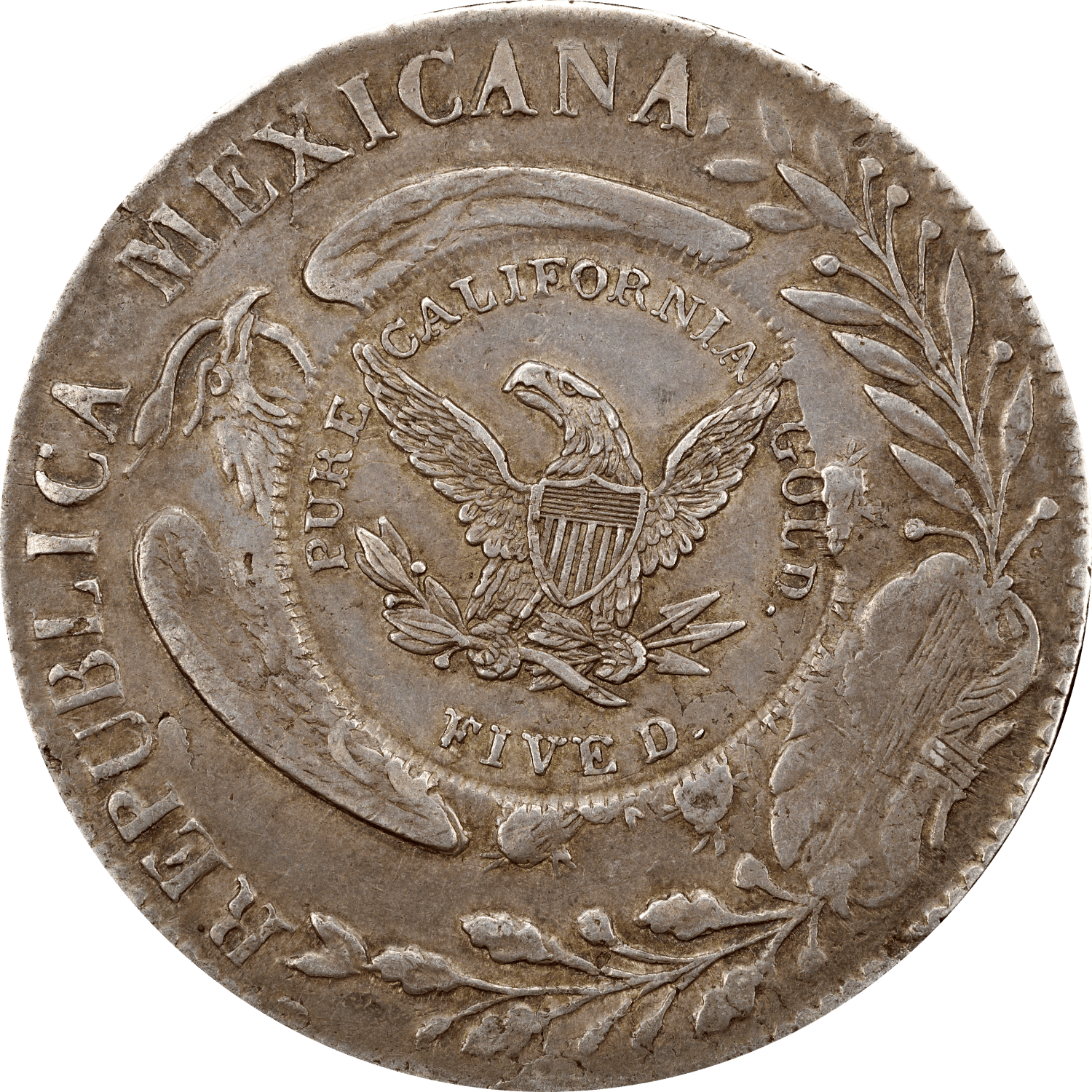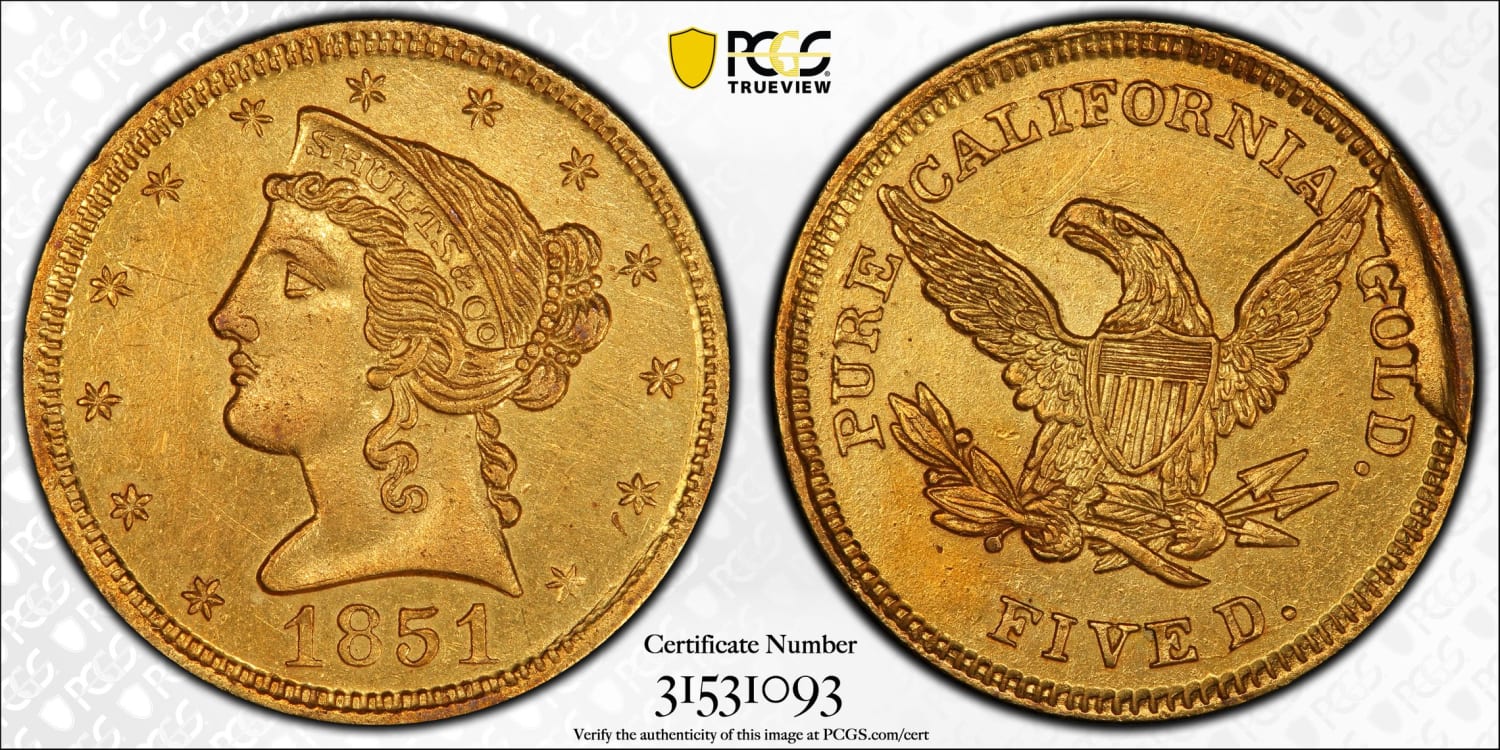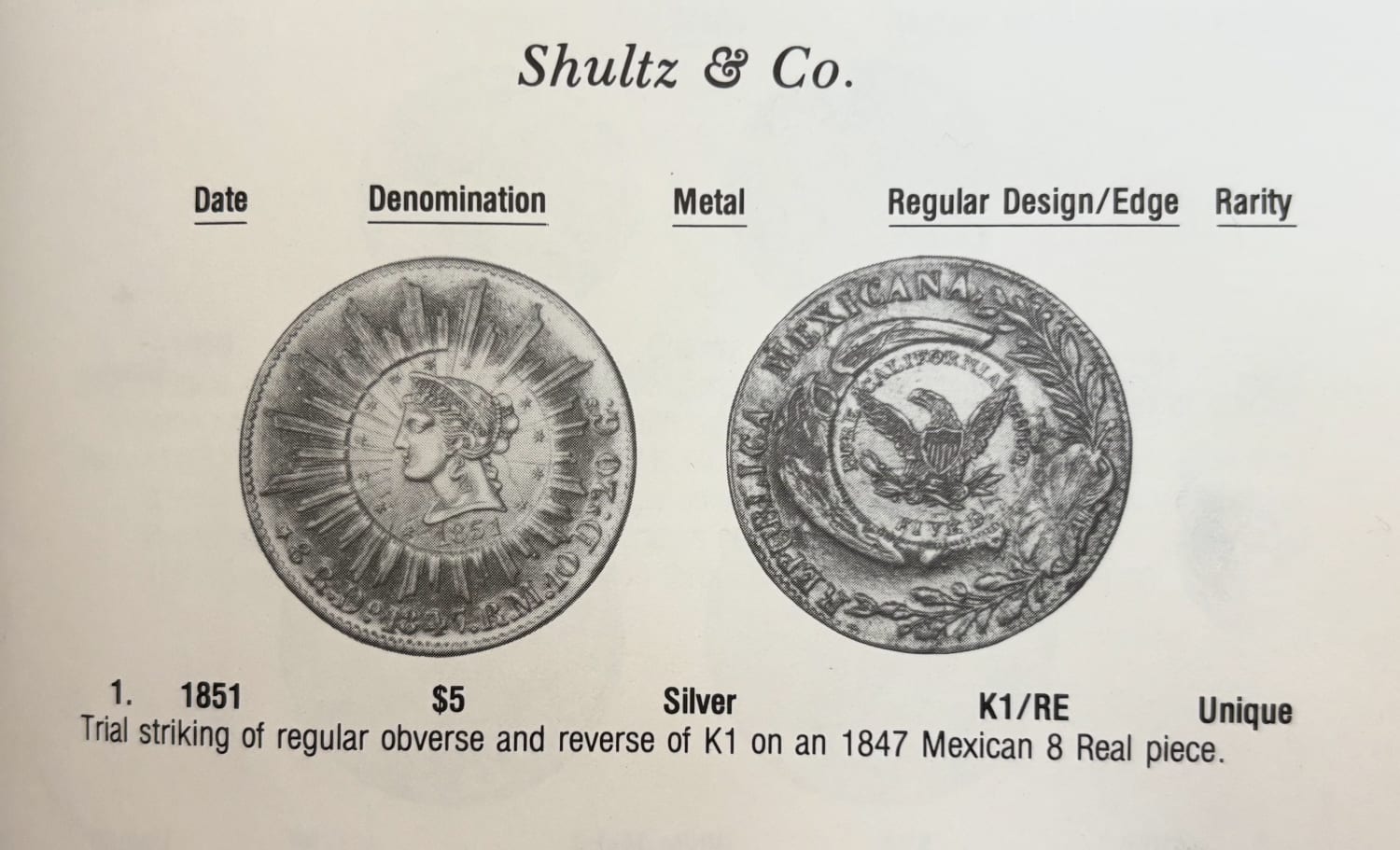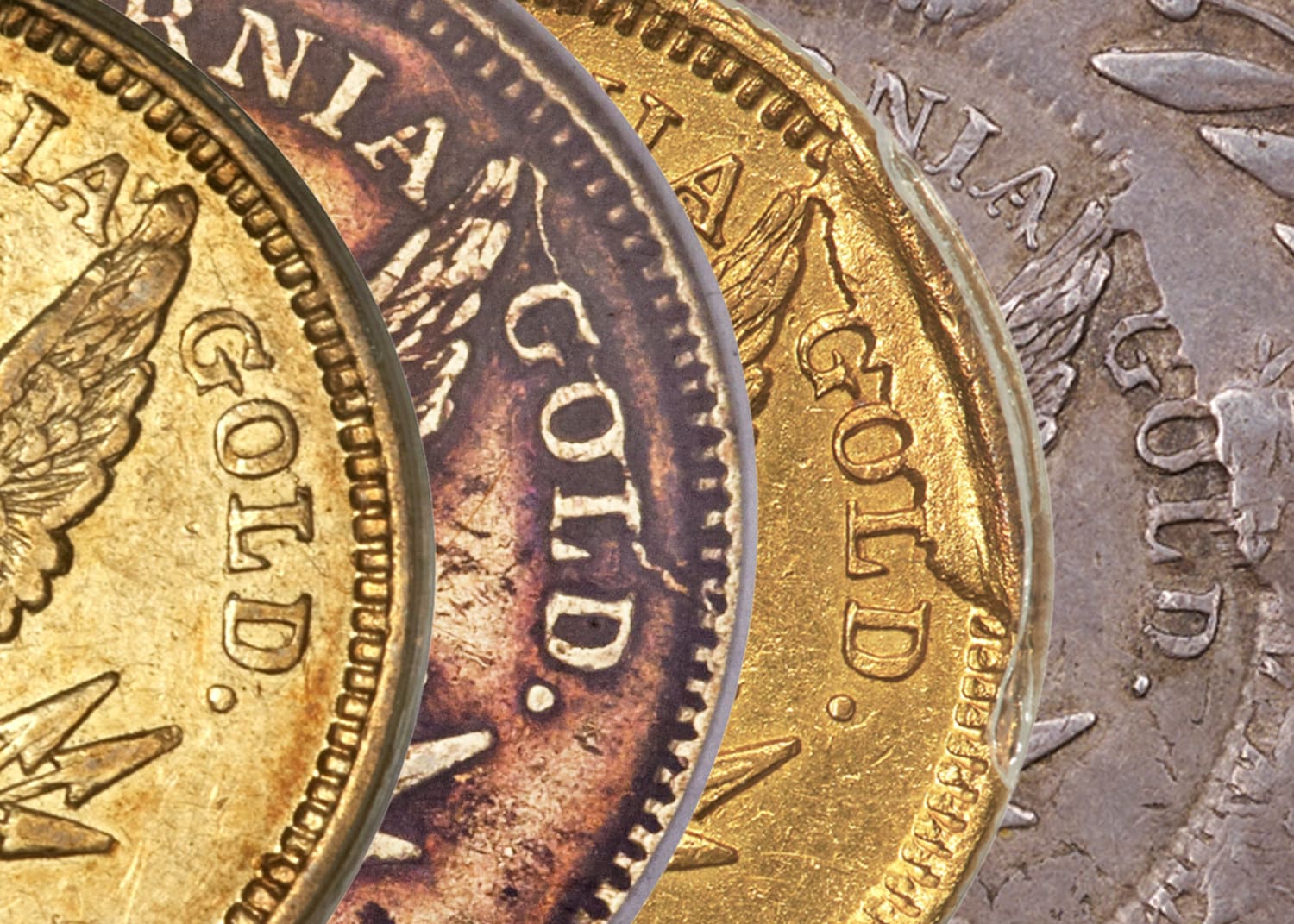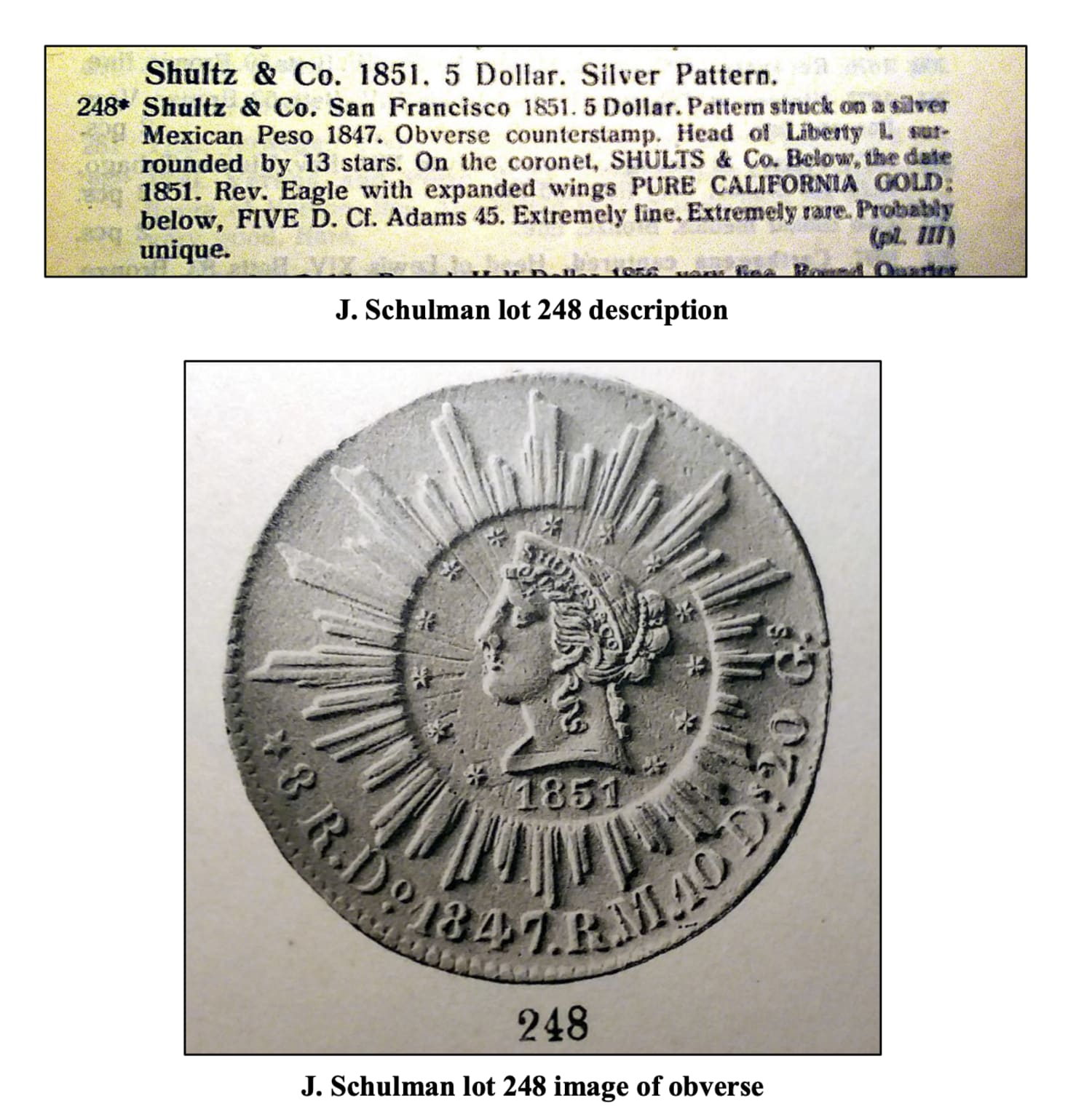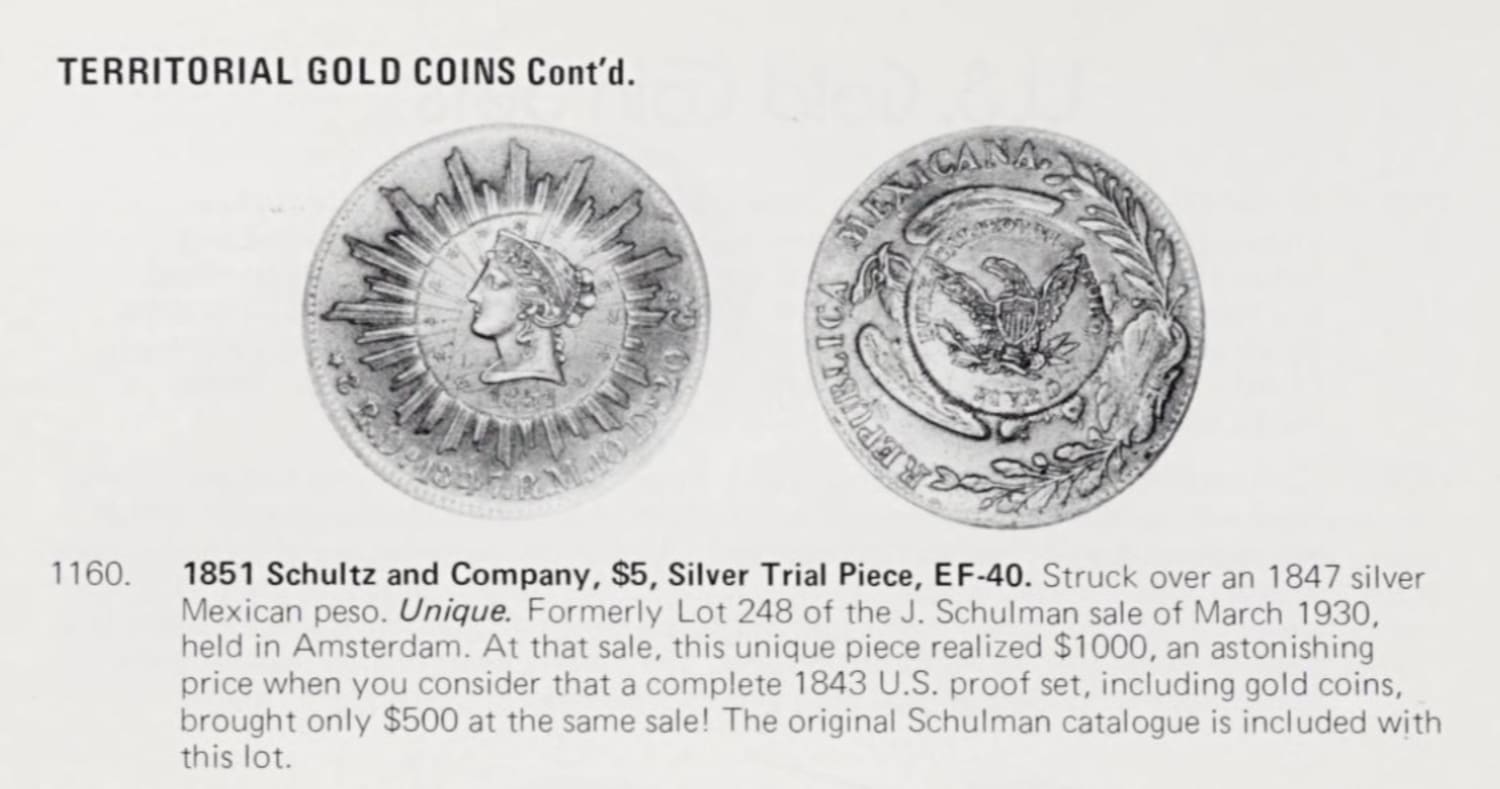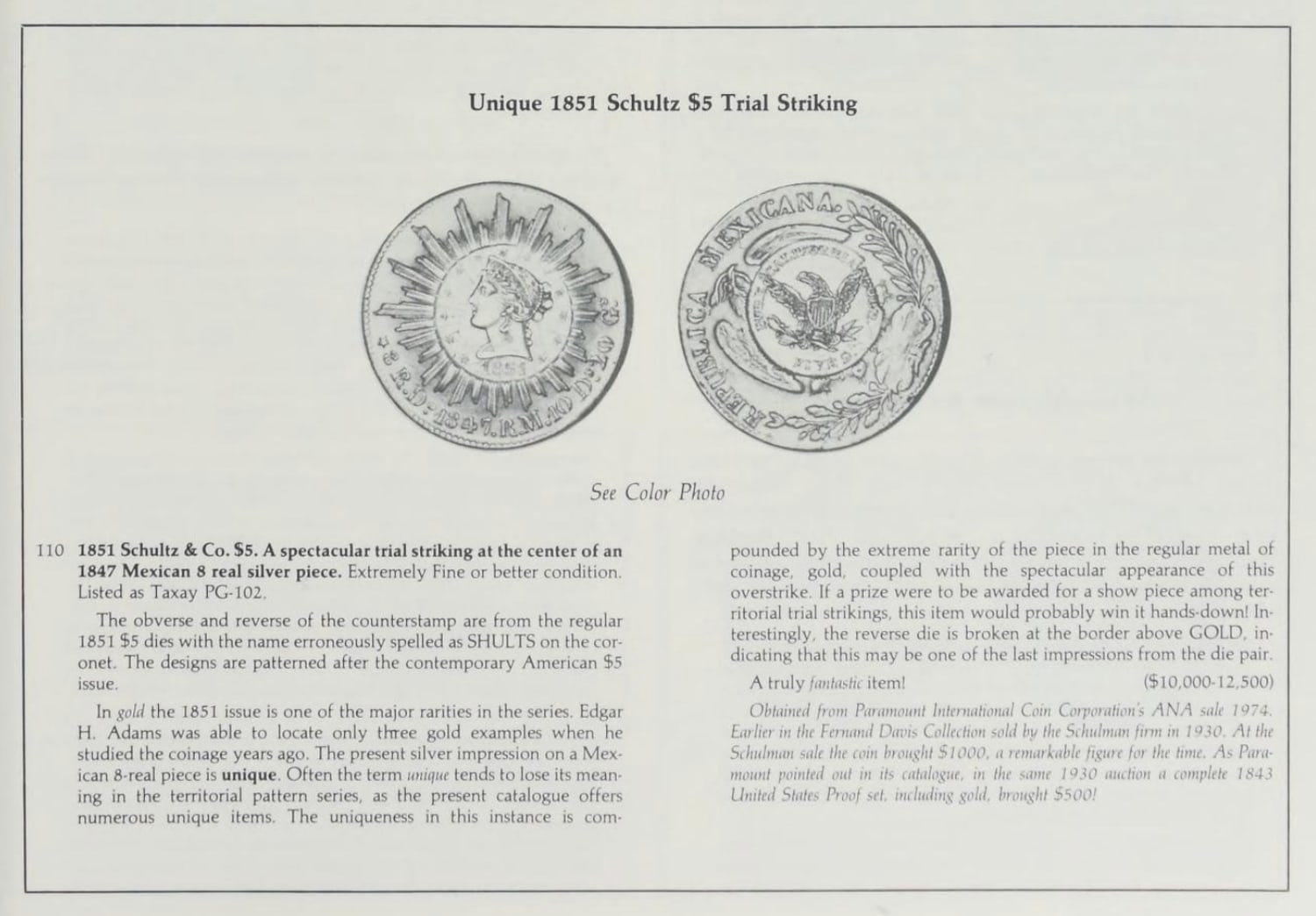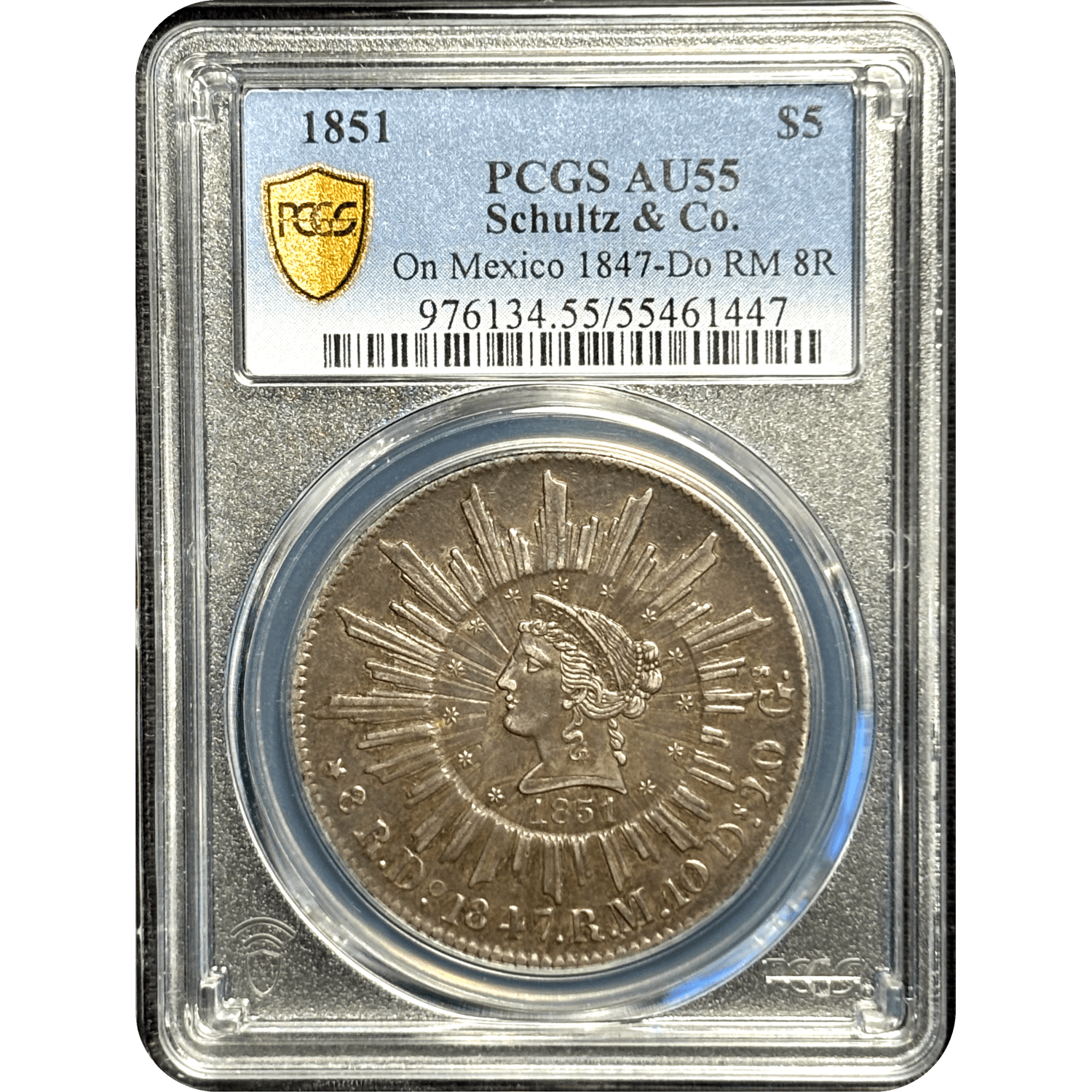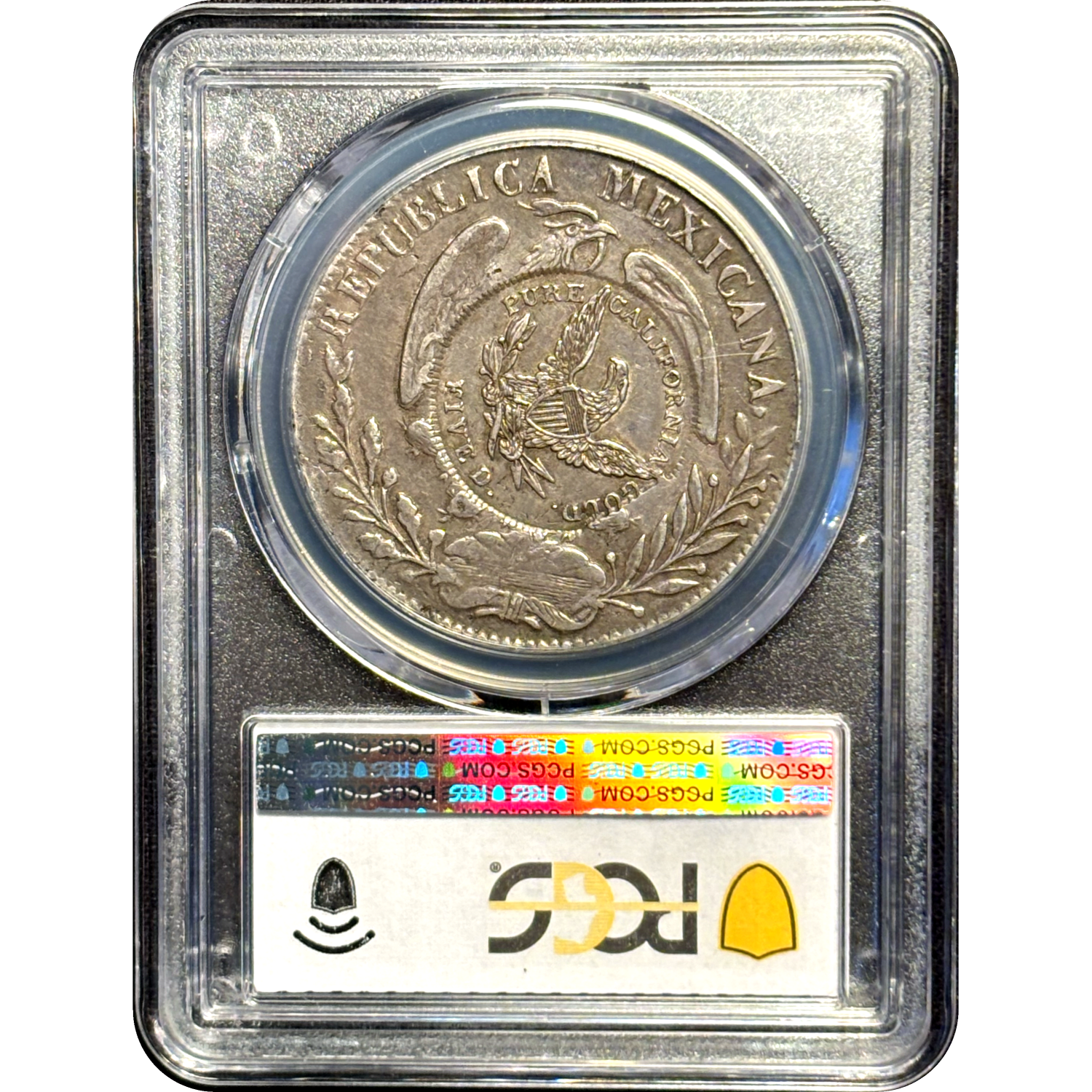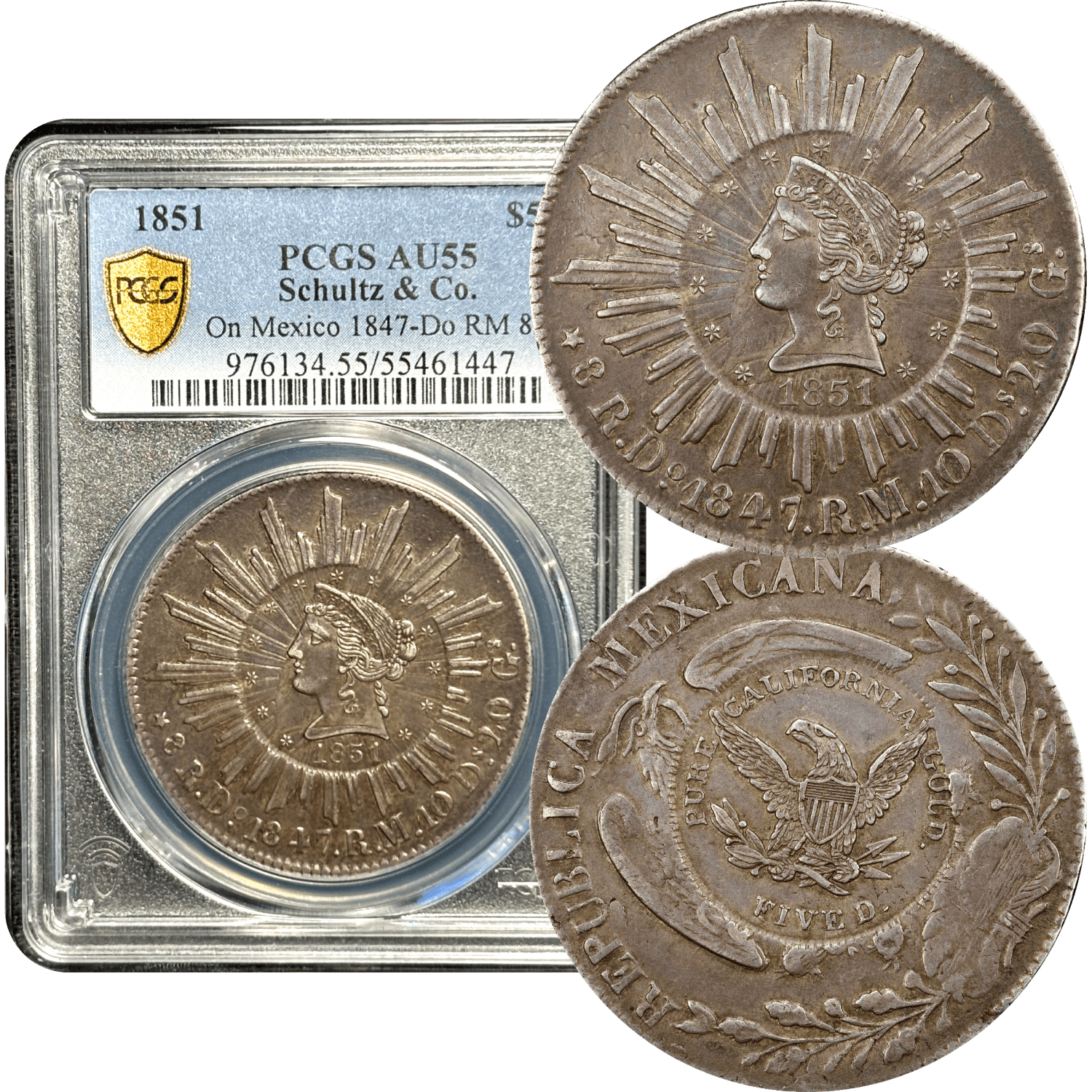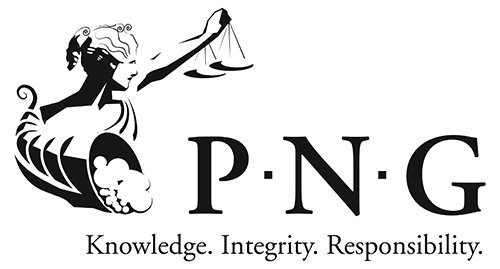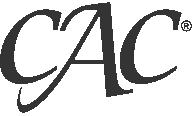Rarity7 (Re)Discovers Unique 1851 $5 Schultz on 1847 Mexico 8R
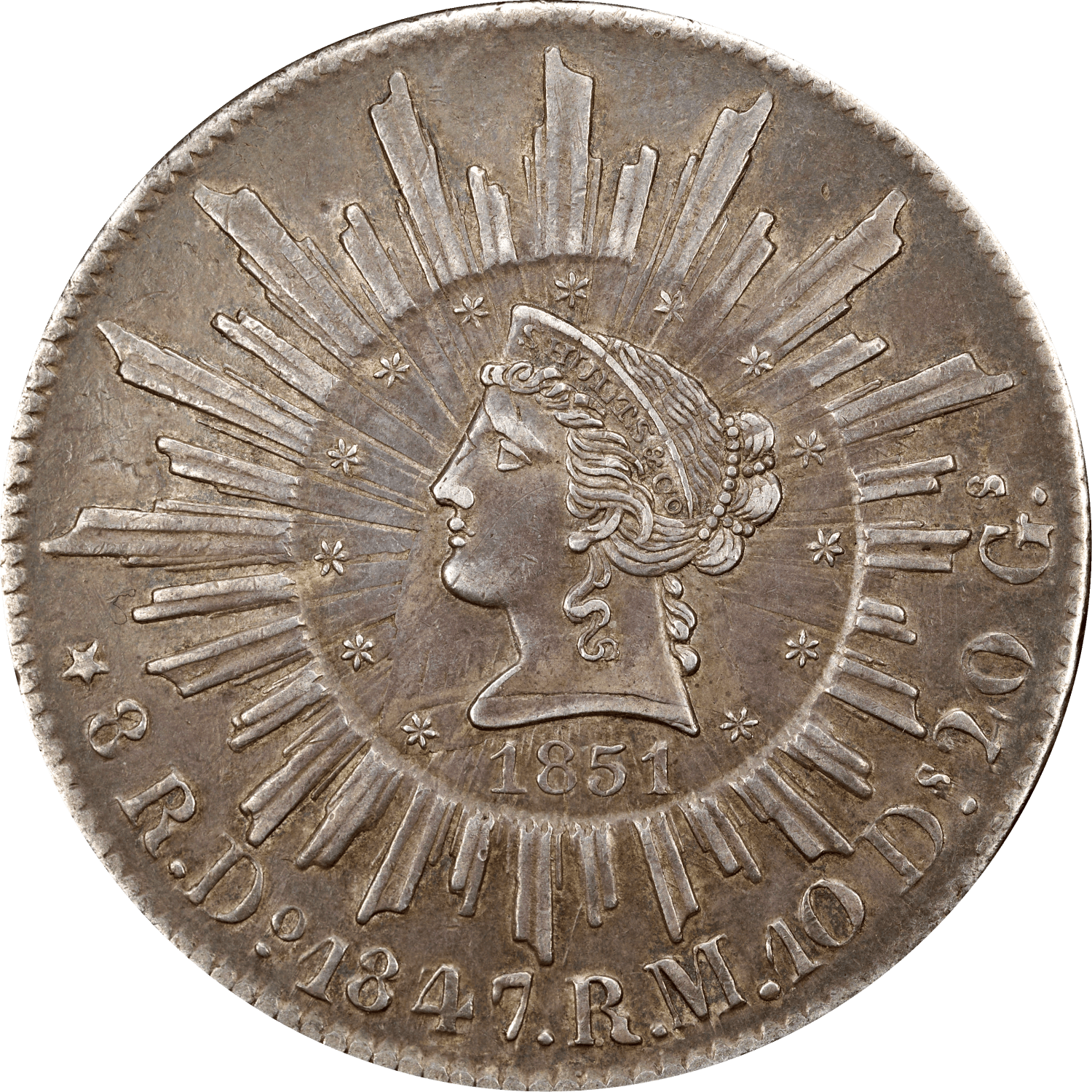
There we were, minding our sweet numismatic business at a local coin show recently when a gentleman walked up to our table and handed Paul this very odd-looking coin.
"What...on earth...is this?" they asked each other.
Noah was pricing up some coins on his laptop and half-listening to the conversation.
Paul wondered aloud: "It looks almost like a $5 Liberty struck on...is that a Mexican 8 Reales? But it doesn't say Liberty on her headband...it says something else..."
Noah perked up.
"And on the reverse...that doesn't look like it says United States of America, it says 'PURE CALIFORNIA'..."
Record skip
Usually when one sees a coin like this - a coin that simply boggles the mind and senses - one's first instinct is to assume the worst. Noah's head started spinning with visions of $0.99 eBay replicas...
But something about this coin felt different. It looked genuinely worn, not fake-antiqued. Liberty's headband read "SHULTS & CO" - a very specific reference to a very rare issue. The reverse had that telltale Pioneer inscription "PURE CALIFORNIA GOLD". This felt a wee too specific to be in the purview of an AliExpress factory.
We purchased it from the seller. There's always risk in buying raw, unauthenticated, esoteric pieces like this. Nine out of ten times they turn out to be exactly what we fear: nothing significant. But occasionally we're surprised! That's both the risk and fun of being a rare coin dealer. We took a gamble and then jumped into researching what it was we now had (and how it made its way to a small coin show in San Jose, CA).
The first thing we did after buying it was immediately send a picture to Owen, our Lead Numismatist. He quickly recognized this as something special:
"That’s a genuine striking of a Schultz $5. It’s real. I know it. And I bet it's exceedingly rare."
And with that, we started digging...
Some Pioneer History
First, a fast rewind to mid-1800s San Francisco: Gold was discovered at Sutter's Mill on January 24th of 1848 and soon over 300,000 people from across the country and around the world flocked to the Bay Area.
San Francisco had gold by the shovel-load but not enough coins to keep daily commerce flowing. The federal branch mint in San Francisco would not open until 1854, so the market improvised. Assayers and entrepreneurs stepped into the vacuum by buying raw gold, refining it, and striking practical money for a city that was exploding by the hour.
Some of the startups were more successful than others. The firm of Norris, Gregg & Norris was first out of the gate in mid-1849, operating through the end of 1850. Moffat & Co.’s product was very well-received and they struck thousands of $5, $10, and $20 coins from 1849 through 1853. There were at least a dozen other firms as well.
In 1850, Schultz & Co. was founded by Judge G.W. Schultz and William Thompson Garratt. They hired the German engraver Albert Kuner to design and produce their dies, and in 1851 struck a number of $5 gold pieces.
Their obverse borrowed the familiar classic portrait of Liberty; the headband swapped LIBERTY for SHULTS & CO – an unfortunate misspelling by a busy engraver cranking out dies for multiple companies. The reverse replaced UNITED STATES OF AMERICA with the unmistakable legend PURE CALIFORNIA GOLD.
Heritage sold this for $1,020,000 in January '24
An Odd Pairing
Our coin shows all of that - but it also shows something else: The ghostly fabric of an 1847 Mexican 8 Reales, with rays and legends peeking out like an old mural beneath fresh paint. On the obverse, the sunburst and stars of the Cap-and-Rays halo Liberty; at the perimeter you can read "8R.Do.1847.10 D.20G."
On the reverse, REPUBLICA MEXICANA is still marching around the edge while the Schultz eagle plants itself squarely on top, proudly and unapologetically Californian.
If you’re thinking “die trial,” you’re in good company. We quickly discovered the piece listed as a “trial striking” in a reference book, and for decades collectors have repeated that attribution. But once we had the coin in hand and started comparing it to other Schultz fives, we noticed a few things. There were clues that the piece was not struck early in the die’s life as one would expect from such a trial.
Above the word GOLD on the reverse there is a prominent cud - an unmistakable, raised blob where a chunk of the die face near the rim broke away. We pulled plates of known Schultz fives and laid out a little forensic parade where a story began to unfold: an early-state example with crisp rims and a wispy hint of a crack forming; a middle-state piece with a well-defined, linear crack; and then the late-state coin where the die broke and formed the very cud we see on our piece. Since only a single die pair is known for the issue, that cud is a clock: it tells you this striking came late in (or at the end of?) the life of that hard-working, production die.
That observation sent us down a fresh path. If not a trial in the new-issue experimental sense, then what? Perhaps someone years later had some fun with the original dies? While the precise date of manufacture is impossible to determine, there's strong evidence supporting its creation in the early 1850s:
It seemed unlikely to us that the stars aligned in such a fashion that the dies were discarded without being destroyed, left unscathed by the 1851 Great Fire of San Francisco (which destroyed most of the city), and then were discovered by someone who knew what they were and who happened to own a multi-ton coin press exactly compatible with those original dies.
Consider also the practical realities of striking coinage: Setting dies, dialing in pressure, warming the press - none of that is trivial.
And finally, consider the concrete evidence showing when and how this piece was made:
-
The die surfaces are crisp. There are no signs of environmental decay - no rust pustules, no corrosion, no extra cracks beyond what we see on late-state gold pieces. The cud is the right cud. No evidence whatsoever that the dies aged or otherwise deteriorated.
-
The design alignment, letter punches, and small diagnostics match the lone Schultz die pair used on the regular $5 gold pieces.
-
The Schultz strike is razor sharp and dialed in, a feat that is nearly impossible to imagine being replicated by anyone other than the original manufacturer.
-
The host is a period-perfect 8 Reales dated 1847 - precisely the sort of coin you’d expect circulating through San Francisco in the 1850s. In Gold Rush California you paid with whatever honest silver you had; Mexican coinage was the daily bread of commerce.
-
The pressure and deformation of the underlying design elements on the 8 Reales are consistent with a working setup: sharp central devices, flow lines where you expect them, and the typical periphery “survivors” of an overstrike on a harder, already-coined planchet.
Nothing about the surfaces hints at casting or post-1850s manufacture.
A Trail Across the Atlantic
Chasing the paper trail of this coin then pulled us across the Atlantic. We discovered an auction appearance in the 1930 J. Schulman sale of the Fernand David collection in Amsterdam, where Wayte Raymond described it as “the highlight of the sale.”
David, a Paris-based collector, had a knack for exotica - exactly the sort of cabinet where a San Francisco oddity might land. And there’s a plausible bridge: Albert Kuner, the gifted engraver who was hired to cut the Schultz dies, left San Francisco in 1854, traveled east to New York, and then onward to Le Havre, France that same year.
It’s not hard to imagine this piece, perhaps a gift or thank-you to the man who birthed its design, accompanying the engraver on the move, tucked into a pocket as a calling card from the edge of the world.
Back Home
At the Schulman sale, the coin was purchased by legendary collector Waldo Newcomer where it lived in his collection for decades. The coin is mentioned in an inventory of Newcomer's collection as reported by George Fuld to Eric Newman:
From Newcomer, the coin was purchased by famed dealer/collector F.C.C. Boyd, after which it then made three public sale appearances.
First, it appeared in Abe Kosoff's 1955 Sale as Lot 755:
Then 19 years later it surfaced in the Paramount International Coin Co.'s 1974 ANA Sale, where it appeared as Lot 1160:
And then one final auction appearance 8 years after that in Bowers & Ruddy's 1982 (not 1981 as the Newcomer inventory suggested) sale of the astounding Clifford Collection:
After 1982, it fell quiet until now, when, for whatever reason, it decided to re-emerge from the inherited collection of a local collector and land with us here at Rarity7.
Finally Graded
For the first time in its nearly two-century lifetime, the coin has been authenticated and professionally graded AU55 by PCGS. They describe it exactly as it sits: an 1851 $5 Schultz & Co. struck on a Mexico 1847-Do 8 Reales.
We are beyond thrilled to be the next in the line of (temporary) caretakers of this legendary unique rarity that bridges Mexico, California, Paris, Amsterdam, New York, and back to California.
This coin will be on display at the Rarity7 booth (#1209) at the 2025 ANA World's Fair of Money in Oklahoma City, OK from August 18 - 23, 2025. Stop by and say hello!
